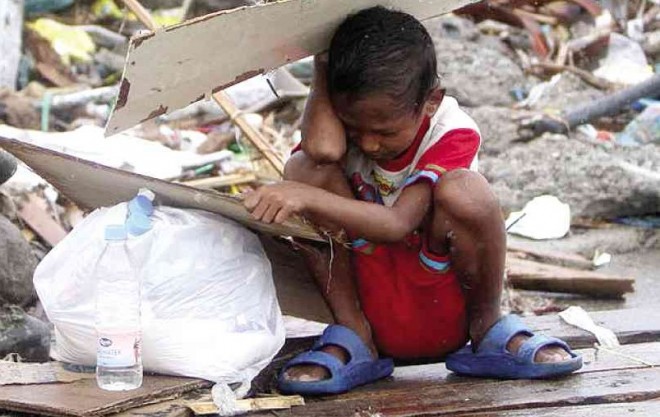
DISASTERS have an immeasurable effect on children who are kept from going to school, like this boy in Tacloban who shields relief for his family from the rain, when classrooms or homes are destroyed. RICHARD A. REYES
MANILA, Philippines — There seems to be no end in sight to the trail of devastation in the Philippines left by Supertyphoon “Yolanda” (internattional codenmae: Haiyan) as disaster authorities announced that the dead or missing has risen to 7,000 people and P22 billion worth of crops, homes and infrastructure have been destroyed.
The confirmed death toll rose to 5,235, with another 1,613 people still missing more than two weeks after Yolanda destroyed entire towns across a long stretch of islands in the central Philippines, the National Disaster Risk Reduction and Management Council (NDRRMC) said in its latest bulletin Saturday.
More than half of the total number of deaths came from the provinces of Eastern Samar, Samar and Leyte with 4,914 fatalities.
The NDRRMC also said that up to P22 billion worth of agriculture and infrastructure were destroyed by the 19- mile per hour winds, the strongest ever recorded on land, and storm surges of up to nine feet.
Yolanda now rivals a 1976 tsunami on the southern island of Mindanao as the deadliest recorded natural disaster to strike the Philippines, which endures a never-ending battle against typhoons, earthquakes, floods and volcanic eruptions.
The typhoon has triggered a giant, international relief effort, with dozens of countries and relief organizations rushing to deliver food, water and health services to more than four million people who lost their homes.
Victims of Supertyphoon “Yolanda” line up for food behind a Department of Social Welfare and Development relief truck amid the ruins of Barangay 88 in San Jose, Tacloban City, on Saturday. FILE PHOTO
However UN humanitarian chief Valerie Amos, after visiting the disaster zones, warned the world was still not responding fast enough to the disaster.
“Much more needs to be done. Food, clean water and shelter remain the top priorities,” Amos said as a UN appeal for funds was raised from $301 million to $348 million.
Amos said huge numbers of people were still exposed to bad weather in the nine provinces ravaged by the storm, as she warned particularly of the dangers for babies, children and mothers.
“I am very concerned that some 1.5 million children are at risk of acute malnutrition and close to 800,000 pregnant and nursing mothers need nutritional help,” Amos told a news conference at UN headquarters.
The World Bank on Friday added $480 million in emergency aid to the Philippines, taking its support to nearly $1 billion. The Asian Development Bank has also offered $500 million concessionary loans.
The US military has performed the highest-profile role in the relief effort, sending an aircraft carrier that arrived six days after the disaster that finally allowed relief supplies to start reaching isolated communities.
Japan also sent more than 1,000 troops aboard three vessels that arrived on Thursday night, in what is the biggest overseas deployment of the country’s military since its defeat in World War II nearly 70 years ago.
China, which is embroiled in a long-running territorial dispute with the Philippines, dispatched a 300-bed hospital ship, while Australia, Britain and Indonesia are among many other nations to have also sent military support.
The number of people confirmed killed jumped by nearly 1,200 on Friday to 5,209, as confirmed body counts were made in some flattened communities, the spokesman for the government’s disaster management council, Reynaldo Balido, told Agence France-Presse.
SURVIVORS of Supertyphoon “Yolanda” arrive at the new Tinago Sports Complex in Cebu City. JUNJIE MENDOZA/CEBU DAILY NEWS
“If you notice, there was not much movement in the death toll for the past few days. This was because the reporting rules required a casualty report signed by the city mayor and his health officer,” he told AFP on Friday night.
“Now, the reports are coming in from the entire typhoon area.”
The death toll rose marginally again on Saturday morning, and was expected to continue rising over the coming days and weeks.
The typhoon on November 8 brought some of the strongest winds ever recorded and generated tsunami-like storm surges that flattened dozens of towns.
In Tacloban, the capital of Leyte province in the eastern Philippines where five-meter (16-feet) waves destroyed most buildings, 1,727 people have been confirmed dead. Another 451 remain missing.
The magnitude of the disaster has continued to stun and overwhelm President Benigno Aquino III’s administration. A few days after the disaster, Aquino said he expected the death toll would be between 2,000 and 2,500.
The Philippines is so prone to natural disasters because it is located along a typhoon belt and the so-called Ring of Fire, a vast Pacific Ocean region where many of Earth’s earthquakes and volcanic eruptions occur.
But the only other natural disaster to compare with Haiyan for ferocity was the tsunami triggered by a magnitude 7.9 earthquake in 1976 that killed between 5,000 and 8,000 people on Mindanao.
Aside from the donations from foreign countries, over P500 million worth of relief assistance was provided to the affected families.
On November 11, Aquino has declared a state of national calamity due to the massive catastrophic damages Yolanda brought to several provinces.
Related Stories:
Glimpses of devastation a day after ‘Yolanda’
More than 10,000 feared dead in typhoon-ravaged Philippines